The 2020 Mac Mini Unleashed: Putting Apple Silicon M1 To The Test
by Andrei Frumusanu on November 17, 2020 9:00 AM ESTBenchmarks: Whatever Is Available
As we’ve had very little time with the Mac mini, and the fact that this not only is a macOS system, but a new Arm64-based macOS system, our usual benchmark choices that we tend to use aren’t really available to us. We’ve made due with a assortment of available tests at the time of the launch to give us a rough idea of the performance:

One particular benchmark that sees the first light of day on macOS as well as Apple Silicon is Cinebench. In this first-time view of the popular Cinema4D based benchmark, we see the Apple M1 toe-to-toe with the best-performing x86 CPUs on the market, vastly outperforming past Apple iterations of Intel silicon. The M1 here loses out to Zen3 and Tiger Lake CPUs, which still seem to have an advantage, although we’re not sure of the microarchitectural characteristics of the new benchmark.
What’s notable is the performance of the Rosetta2 run of the benchmark when in x86 mode, which is not only able to keep up with past Mac iterations but still also beat them.
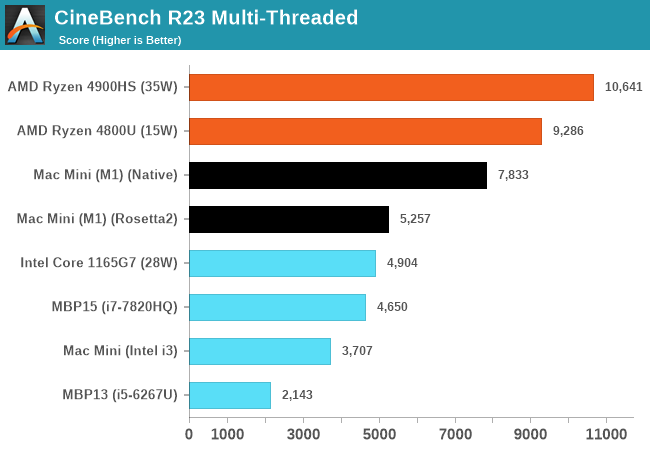
In the multi-threaded R23 runs, the M1 absolutely dominates past Macs with similar low-power CPUs. Just as of note, we’re trying to gather more data on other systems as we have access to them, and expand the graph in further updates of the article past publishing.
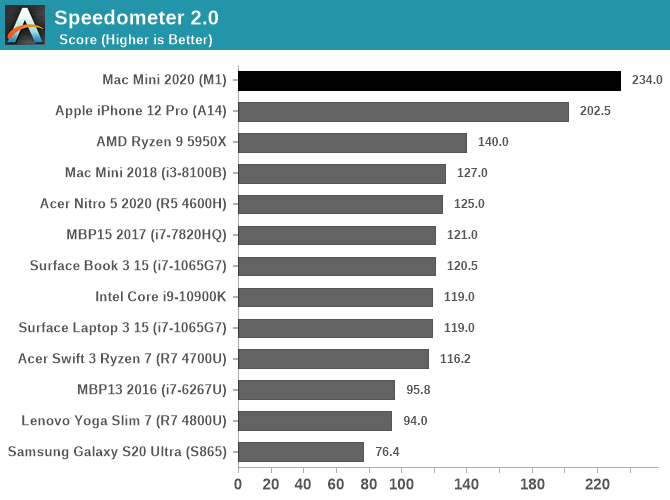
In browser-benchmarks we’ve known Apple’s CPUs to very much dominate across the landscape, but there were doubts as to whether this was due to the CPUs themselves in the iPhone or rather just the browsers and browser engines. Now running on macOS and desktop Safari, being able to compare data to other Intel Mac systems, we can come to the conclusion that the performance advantage is due to Apple’s CPU designs.
Web-browsing performance seems to be an extremely high priority for Apple’s CPU, and this makes sense as it’s the killer workload for mobile SoCs and the workload that one uses the most in everyday life.
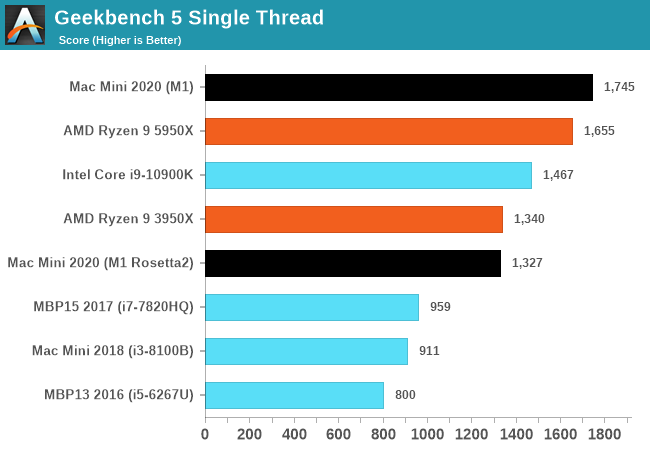
In Geekbench 5, the M1 does again extremely well as it actually takes the lead in our performance figures. Even when running in x86 compatibility mode, the M1 is able to match the top single-threaded performance of last generation’s high-end CPUs, and vastly exceed that of past iterations of the Mac mini and past Macbooks.
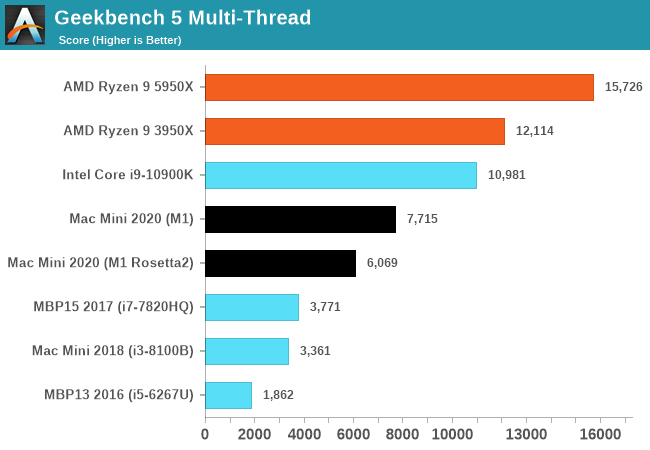
Multi-threaded performance is a matter of core-count and power efficiency of a design. The M1 here demolishes a 2017 15-inch Macbook Pro with an Intel i7-7820HQ with 4 cores and 8 threads, posting over double the score. We’ll be adding more data-points as we collect them.


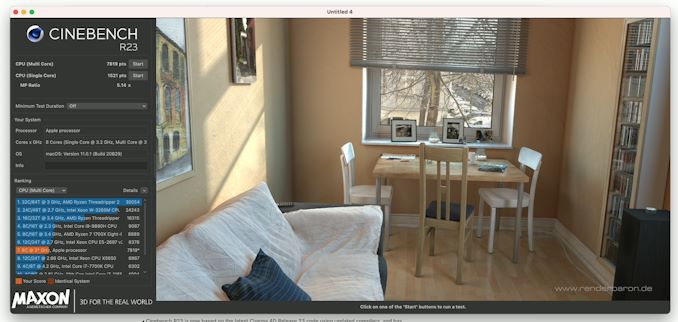








682 Comments
View All Comments
Spunjji - Monday, November 23, 2020 - link
Not really - I don't own a Mac and don't ever plan to unless Boot Camp comes back. You're mistaken to assume I'm personally invested in this; I just don't like shitposters very much.taligentia - Tuesday, November 17, 2020 - link
Not sure what you're rambling about.Macbook Air, Mac Mini and the 13 MBP were always their low-end models.
Wait until their iMac Pro, Mac Pro are released. It will truly shake up the professional market.
KoolAidMan1 - Tuesday, November 17, 2020 - link
They're better at video editing, color correction, and image processing than other PCs.Show me a desktop PC that can scrub 8k video in DaVinci Resolve with no framedrops like the entry-level M1 in a 13" MBP can. Its exceedingly rare and incredibly expensive. I have a Threadripper workstation and am salivating at these
KoolAidMan1 - Tuesday, November 17, 2020 - link
If this is "entry level" then I can't wait to see what their high end machines with 32GB+ of RAM look like next yearhaghands - Tuesday, November 17, 2020 - link
Did you look at a single benchmark? Are benchmarks too complicated for your single brain cell?Silma - Tuesday, November 17, 2020 - link
It's good to have more competition.However, let's temper these praises: 2 of the most paramount reasons explaining this chip speed are not apple: microarchitecture is ARM, production is TSMC 5 nm.
The speed and power consumption of any Intel processor but made in 5 nm would be much similar to that of the M1.
Even from AMD we can expect automatically much better results in 5 nm than in 7 nm.
I would be very interested in seeing how competitive another ARM based TSCM 5 nm based SoC vs the M1. Perhaps from Qualcom or someone else.
Otritus - Tuesday, November 17, 2020 - link
Tsmc's 5nm node offers about a 30 decrease in power consumption over 7nm. That would imply a 28-34 watt tdp at 7nm which still keeps it ahead in efficiency. In terms of performance, no AMD and Intel would not perform better on 5nm. There is no reason to believe the TSMC 5nm process can clock higher(or even as high) than the 7nm process. Since performance is equal to ipc times clock speed, a new microarchitecture would be needed to perform better. Apple has over a 50 percent ipc lead over intel and over a 40 percent ipc lead over AMD.AlexDaum - Tuesday, November 17, 2020 - link
An AMD or Intel CPU on 5nm would not gain performance by higher clock speeds, but gain it using a wider CPU design, larger caches, more ALUs, probably a better branch predictor and larger reorder buffer. The M1 has a whopping 16 billion transistors, AMD renoir only 9.6 billion, so they could add a lot more logic on the same chip size, which would lead to better performance.The biggest challenge with scaling x86 CPUs to higher performance seems to be building wide decoders (AMD and Intel only have 4 wide decode, M1 has 8 wide, 1 x86 instruction can do more than 1 ARM64 instruction, but not twice as much).
andreltrn - Tuesday, November 17, 2020 - link
The problem with the X86 instruction set is that it has instruction of different size that don't match a wider architecture favorably. It is not that easy to achieve the high degree of parallelism of the M1 architecture with the X86 Instruction set. The 16 billions transistors are not only for the CPU and the GPU. There is a lot more in there! You can't compare the transistor count like that. This is a SOC.Otritus - Wednesday, November 18, 2020 - link
@AlexDaum1) As I said a new microarchitecture would be needed.
2) Ice/tiger lake already has 5 decoders (4 simple + 1 complex), and tremont has 6 decoders (run as 2 sets of 3, but intel says it can run as 1 set of 6).
3) Apples firestorm cores was designed for 2020 using the latest technology. Sunny cove was supposed to launch in 2017/18, with the next gen microarchitecture coming 2020/21. Intel also got lazy and didn't feel a need to speed up microarchitecture development and improve performance tremendously. So, intel is at 4/5 decoders with weak ipc compared to the competition.
4) AMD is still at 4 decoders because they have a limited engineering budget and need to focus on getting the best ROI. I would imagine zen 4 or zen 5 would look into going much wider because lots of the other performance enhancing routes have already been investigated, and AMD is in a better financial situation.